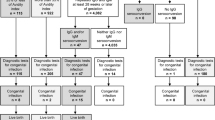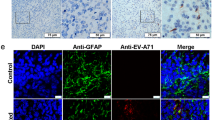Abstract
Lymphocytic choriomeningitis virus (LCMV) is a prevalent pathogen, whose natural host and reservoir is the wild mouse. Humans can be infected when they contact the secretions of mice. Most infections of postnatal humans result in mild illness. However, the consequences can be severe when the infection occurs during pregnancy, as the virus crosses the placenta to infect the fetus. LCMV infection of the human fetus can lead to severe neuropathologic effects, including microencephaly, hydrocephalus, focal destructive lesions, and cerebellar hypoplasia. Outcomes among children with congenital LCMV are variable, but most are permanently and severely disabled. The neonatal rat inoculated with LCMV models human prenatal infection. The rat model has demonstrated that effects of LCMV depend on host age at the time of infection. Some effects, including encephalomalacia and neuronal migration disturbances, are immune-mediated and depend on the actions of T-lymphocytes. Other effects, including cerebellar hypoplasia, are virus-mediated and do not depend on T-lymphocytes. Cerebellar neuronal migration disturbances are caused by immune-mediated corruption of Bergmann glia structure. The rat pup inoculated with LCMV is a superb animal model for human congenital infection. All neuropathologic effects observed in human congenital LCMV infection can be recapitulated in the rat model.
Impact
-
Lymphocytic choriomeningitis virus (LCMV) is a prevalent human pathogen that can cause serious neurologic birth defects when the infection occurs during pregnancy.
-
The effects of the virus on the developing brain depend strongly on the age of the host at the time of infection.
-
Some of the pathologic effects of LCMV are immune-mediated and are driven by T-lymphocytes, while other pathologic effects are due to the virus itself.
This is a preview of subscription content, access via your institution
Access options
Subscribe to this journal
Receive 14 print issues and online access
$259.00 per year
only $18.50 per issue
Buy this article
- Purchase on Springer Link
- Instant access to full article PDF
Prices may be subject to local taxes which are calculated during checkout





Similar content being viewed by others
References
Vilibic-Cavlek, T. et al. Lymphocytic choriomeningitis-emerging trends of a neglected virus: a narrative review. Trop. Med. Infect. Dis. 6, 88 (2021).
Olivieri, N. R., Othman, L., Flannery, D. D. & Gordon, S. M. Transmission, seroprevalence, and maternal-fetal impact of lymphocytic choriomeningitis virus. Pediatr. Res. https://doi.org/10.1038/s41390-023-02859-w (2023).
Castellar, A. et al. First evidence of lymphocytic choriomeningitis virus (arenavirus) infection in Mus musculus rodents captured in the urban area of the municipality of Sincelejo, Sucre, Colombia. Biomedica 37, 75–85 (2017).
Childs, J. E., Glass, G. E., Korch, G. W., Ksiazek, T. G. & Leduc, J. W. Lymphocytic choriomeningitis virus infection and house mouse (mus musculus) distribution in urban Baltimore. Am. J. Trop. Med. Hyg. 47, 27–34 (1992).
Talley, P., Holzbauer, S., Smith, K. & Pomputius, W. Notes from the field: lymphocytic choriomeningitis virus meningoencephalitis from a household rodent infestation – Minnesota, 2015. Morb. Mortal. Wkly Rep. 65, 248–249 (2016).
Ambrosio, A. M., Feuillade, M. R., Gamboa, G. S. & Maiztegui, J. I. Prevalence of lymphocytic choriomeningitis virus infection in a human population of Argentina. Am. J. Trop. Med. Hyg. 50, 381–386 (1994).
Stephensen, C. B. et al. Prevalence of serum antibodies against lymphocytic choriomeningitis virus in selected populations from two U.S. cities. J. Med. Virol. 38, 27–31 (1992).
Bonthius, D. J. Lymphocytic choriomeningitis virus: a prenatal and postnatal threat. Adv. Pediatr. 56, 75–86 (2009).
Bonthius, D. J. & Karacay, B. Meningitis and encephalitis in children: an update. Neurol. Clin. 20, 1013–1038 (2002).
Armstrong, C. & Lillie, R. D. Experimental lymphocytic choriomeningitis of monkeys and mice produced by a virus encountered in studies of the 1933 St. Louis encephalitis epidemic. Public Health Rep. 49, 1019–1022 (1934).
Folk, S. et al. Lymphocytic choriomeningitis with severe manifestations, Missouri, USA. Emerg. Infect. Dis. 17, 1973–1974 (2011).
Fischer, S. A. et al. Transmission of lymphocytic choriomeningitis virus by organ transplantation. N. Engl. J. Med. 354, 2235–2249 (2006).
Centers for Disease Control and Prevention. Lymphocytic choriomeningitis virus transmitted through solid organ transplantation—Massachusetts, 2008. Morb. Mortal. Wkly Rep. 57, 799–801 (2008).
Bonthius, D. J. Lymphocytic choriomeningitis virus: an underrecognized cause of neurologic disease in the fetus, child and adult. Semin. Pediatr. Neurol. 19, 89–95 (2012).
Komrower, G. M., Williams, B. L. & Stones, P. B. Lymphocytic choriomeningitis in the newborn. Probable transplacental infection. Lancet 1, 697–698 (1955).
Barton, L. L. et al. Congenital lymphocytic choriomeningitis virus infection in twins. Pediatr. Infect. Dis. J. 12, 942–946 (1993).
Larsen, P. D., Chartrand, S. A., Tomashek, K. M., Hauser, L. G. & Ksiazek, T. G. Hydrocephalus complicating lymphocytic choriomeningitis virus infection. Pediatr. Infect. Dis. J. 12, 528–531 (1993).
Ansari, N., Demmler-Harrison, G., Coats, D. K. & Paysse, E. A. Severe congenital chorioretinitis caused by congenital lymphocytic choriomeningitis virus infection. Am. J. Ophthalmol. Case Rep. 22, 101094 (2021).
Barton, L. L., Peters, C. J. & Ksiazek, T. G. Lymphocytic choriomeningitis virus: an unrecognized teratogenic pathogen. Emerg. Inf. Dis. 1, 152–153 (1995).
Barton, L. L. & Mets, M. B. Congenital lymphocytic choriomeningitis virus infection: decade of rediscovery. Clin. Infect. Dis. 33, 370–374 (2001).
Wright, R. et al. Congenital lymphocytic choriomeningitis virus syndrome: a disease that mimics congenital toxoplasmosis or cytomegalovirus infection. Pediatrics 100, 1–6 (1997).
Bonthius, D. J. et al. Congenital lymphocytic choriomeningitis virus infection: spectrum of disease. Ann. Neurol. 62, 347–355 (2007b).
Olivieri, N. R., Othman, L. & Gordon, S. M. Health disparities revealed in a case of congenital LCMV. Pediatr. Res https://doi.org/10.1038/s41390-023-02772-2 (2023).
Biggar, R., Woodall, J., Walter, P. & Haughie, G. Lymphocytic choriomeningitis outbreak associated with pet hamsters: fifty-seven cases from New York state. JAMA 232, 494 (1975).
Monjan A. A., Cole G. A. & Nathanson N. Pathogenesis of LCM disease in the rat. In: Lymphocytic choriomeningitis Virus and Other Arenaviruses (Lehmann F., ed) 195–206 (Springer-Verlag, New York, 1973).
Bonthius, D. J. & Perlman, S. Congenital viral infections of the brain: lessons learned from lymphocytic choriomeningitis virus in the neonatal rat. PLoS Pathog. 3, 1541–1550 (2007).
Bonthius, D. J., Mahoney, J. C., Buchmeier, M. J. & Taggard, D. A. Critical role for glial cells in the propagation and spread of lymphocytic choriomeningitis virus in the developing rat brain. J. Virol. 76, 6618–6635 (2002).
Bonthius, D. J., Nichols, B., Harb, H., Mahoney, J. & Karacay, B. Lymphocytic choriomeningitis virus infection of the developing brain: critical role of host age. Ann. Neurol. 62, 356–374 (2007a).
Klein, H., Rabe, G. K., Karacay, B. & Bonthius, D. J. T-cells underlie some, but not all, of the cerebellar pathology in a neonatal rat model of congenital lymphocytic choriomeningitis virus infection. J. Neuropathol. Exp. Neurol. 75, 1031–1047 (2016).
Sun, T., Vasek, M. J. & Klein, R. S. Congenitally acquired persistent lymphocytic choriomeningitis viral infection reduces neuronal progenitor pools in the adult hippocampus and subventricular zone. PLoS One 9, e96442 (2014).
Albarino, C. G. et al. High diversity and ancient common ancestry of lymphocytic choriomeningitis virus. Emerg. Inf. Dis. 16, 1093–1110 (2010).
Plume, J. M., Todd, D. & Bonthius, D. J. Viral strain determines disease symptoms, pathology, and immune response in neonatal rats with lymphocytic choriomeningitis virus infection. Viruses 11, 1–22 (2019).
Bonthius, D. J. Diagnosed cases of congenital LCMV infection: tip of the iceberg. Ann. Neurol. 64, 356 (2008).
Tevaearai, F., Moser, L. & Pomar, L. Prenatal diagnosis of congenital lymphocytic choriomeningitis virus infection: a case report. Viruses 14, 1–9 (2022).
Acknowledgements
Supported by grants from the NIH (K08-NS02007, T32-HD041922, F31-NS051161), March of Dimes Birth Defects Foundation (MOD-1-FY01-217), Child Neurology Society Young Investigator Award, and the Atrium Health Research Foundation. The author thanks Jo Mahoney, Glenda Rabe, Hannah Klein, and Jeffrey Plume for their technical and intellectual contributions.
Author information
Authors and Affiliations
Contributions
D.J.B. conceived the work reported here, wrote the manuscript, and produced the figures.
Corresponding author
Ethics declarations
Competing interests
The author declares no competing interests.
Additional information
Publisher’s note Springer Nature remains neutral with regard to jurisdictional claims in published maps and institutional affiliations.
Rights and permissions
Springer Nature or its licensor (e.g. a society or other partner) holds exclusive rights to this article under a publishing agreement with the author(s) or other rightsholder(s); author self-archiving of the accepted manuscript version of this article is solely governed by the terms of such publishing agreement and applicable law.
About this article
Cite this article
Bonthius, D.J. Lymphocytic choriomeningitis virus injures the developing brain: effects and mechanisms. Pediatr Res 95, 551–557 (2024). https://doi.org/10.1038/s41390-023-02985-5
Received:
Revised:
Accepted:
Published:
Issue Date:
DOI: https://doi.org/10.1038/s41390-023-02985-5



